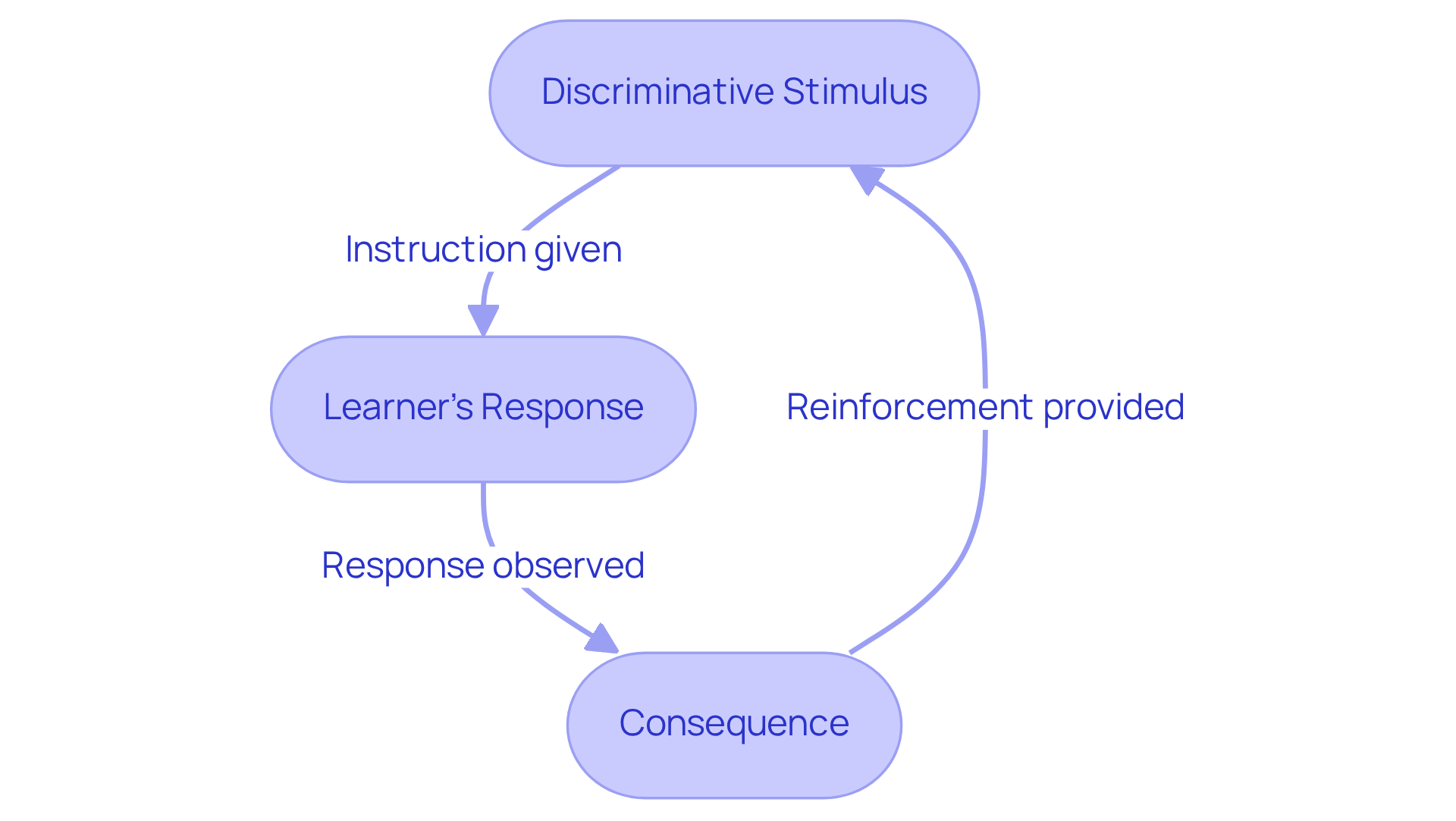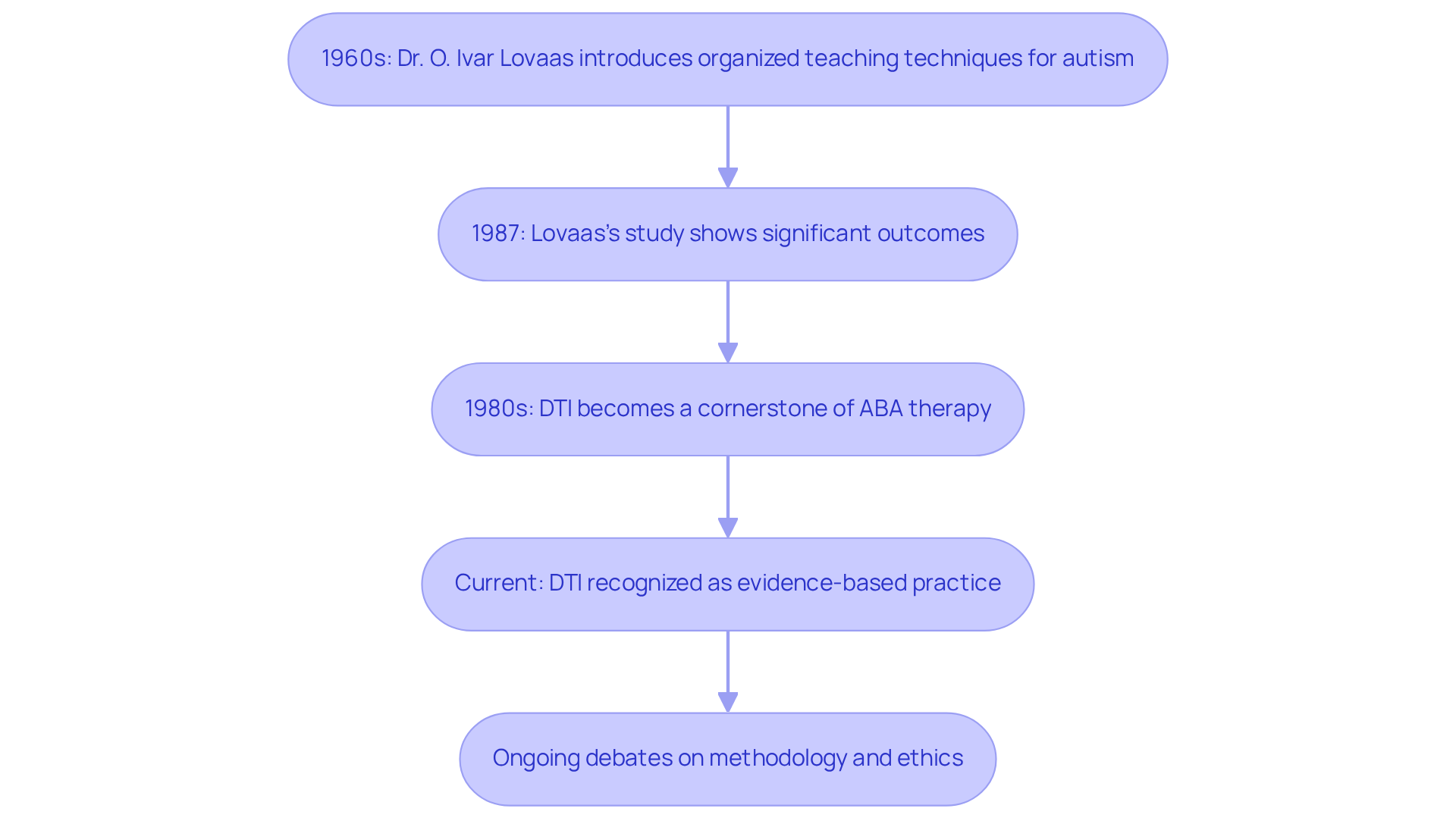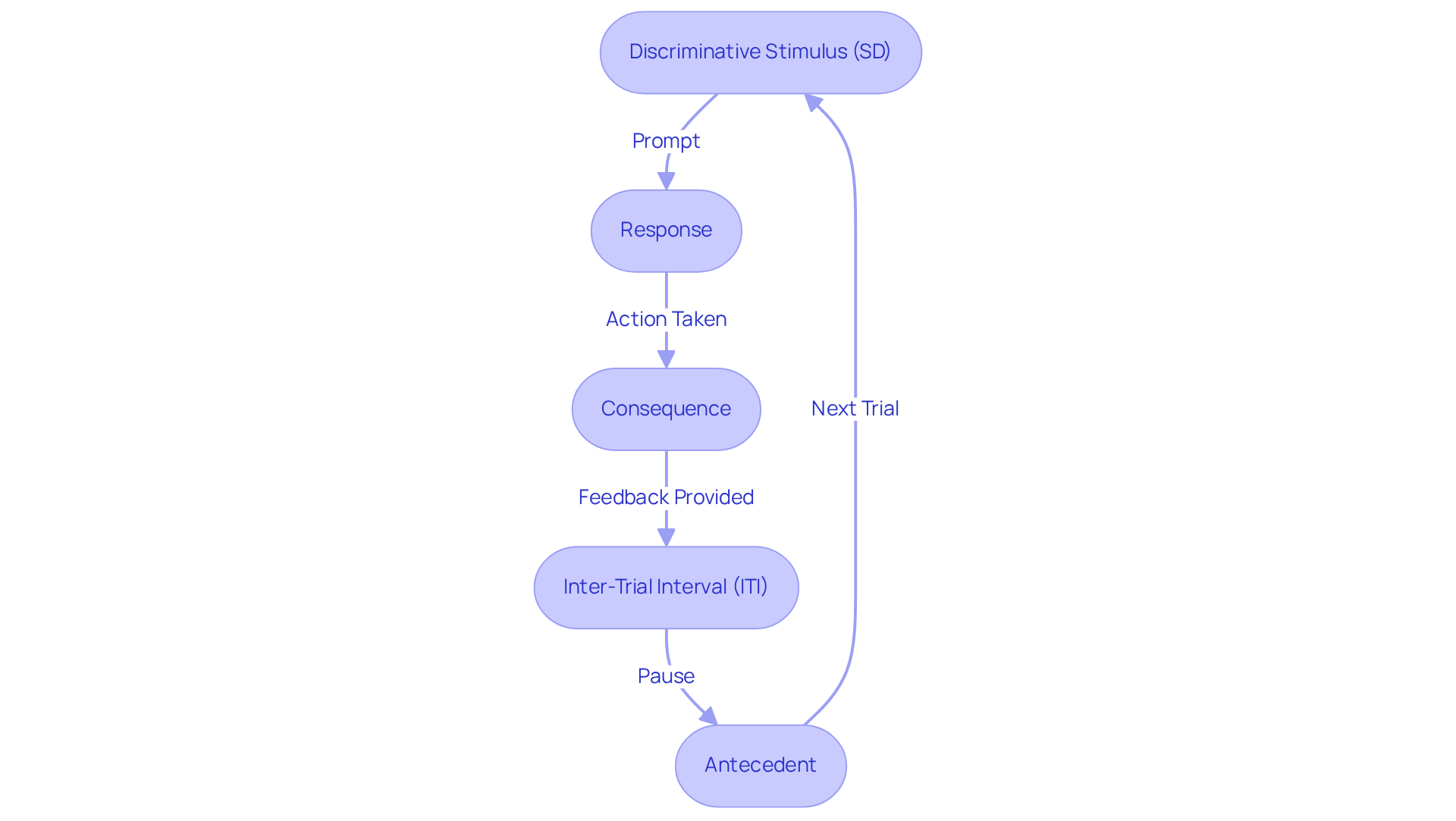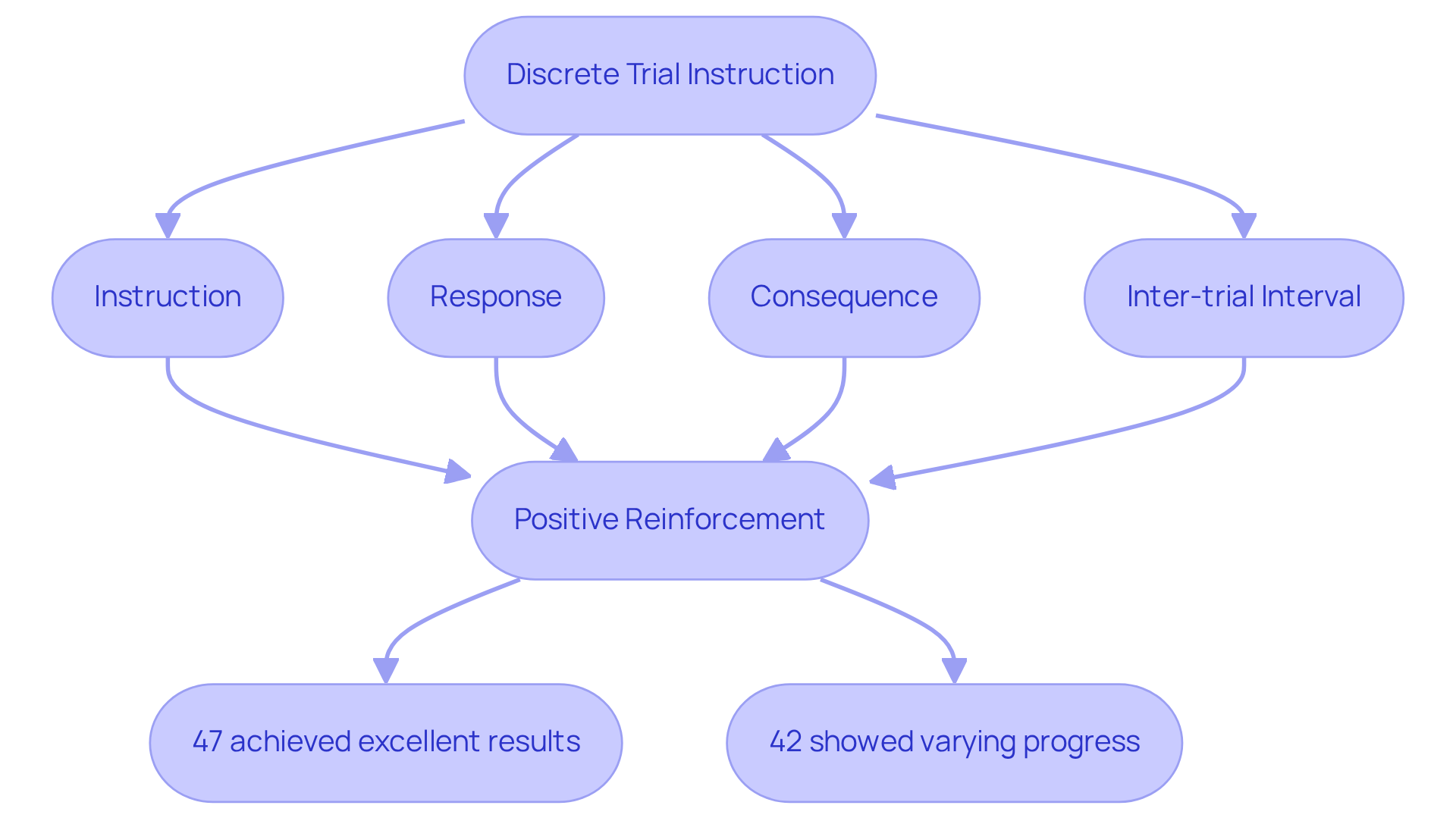September 11, 2025

Discrete Trial Instruction (DTI) stands as a pivotal teaching method within Applied Behavior Analysis (ABA), meticulously breaking down complex skills into smaller, manageable components. This structured approach facilitates focused learning for individuals with autism.
Research underscores DTI's effectiveness, showcasing a clear framework of instruction, response, and reinforcement, leading to significant improvements in communication and social skills among learners. As the demand for Board Certified Behavior Analysts (BCBAs) continues to rise, understanding and implementing DTI becomes increasingly essential.
By leveraging DTI, educators can enhance their teaching strategies, ultimately fostering better outcomes for their students. Consider how integrating DTI into your practice can transform your approach and yield remarkable results.
Discrete Trial Instruction (DTI) serves as a foundational element of Applied Behavior Analysis (ABA), meticulously crafted to deconstruct complex skills into manageable segments for effective learning. This structured approach not only elevates the educational experience for individuals with autism but also catalyzes significant advancements in communication and social interaction.
As discussions persist regarding its methodology and ethical considerations, one must reflect: what truly characterizes the effectiveness of DTI, and how can it be refined to address the diverse needs of learners?
Discrete Trial Instruction (DTI) is a highly organized teaching approach within [Applied Behavior Analysis (ABA)](https://hireaba.today), illustrating what type of intervention is discrete trial instruction by breaking down complex abilities into smaller, manageable components. Each component is taught through distinct trials, where specific abilities or behaviors are presented, practiced, and reinforced. This method, which is an example of what type of intervention is discrete trial instruction, is particularly beneficial for individuals with autism, promoting focused learning in a personalized environment and enhancing the capacity to systematically develop new skills.
DTI is defined by its clear structure, which incorporates:
For instance, when teaching communication skills, a therapist may encourage a young learner to articulate 'apple,' providing immediate praise or a reward for accurate responses. This is vital, as it helps young individuals associate correct behaviors with favorable outcomes, motivating them to replicate these actions in future trials.
Moreover, data collection during DTI sessions is essential for monitoring progress and guiding adjustments to teaching strategies, ensuring that the method remains effective and tailored to each student's needs. Research supports the efficacy of discrete trial instruction, answering the question of what type of intervention is discrete trial instruction by demonstrating significant improvements in communication skills, social interaction, and independence in daily tasks for individuals with autism.
By segmenting tasks into smaller steps and employing structured instruction, DTI not only enhances learning outcomes but also builds confidence in young learners as they acquire new abilities. The ABC model (Antecedent, Behavior, Consequence) is integral to DTI, steering the teaching process and aiding students in understanding the relationship between their actions and the resulting outcomes. Additionally, incorporating inter-trial intervals (ITIs) helps sustain focus and engagement during sessions, preventing fatigue and enriching the learning experience.
Parents play a critical role in reinforcing DTI techniques at home, which can accelerate progress and foster greater consistency in skill application.

The roots of Discrete Trial Instruction (DTI) can be traced back to Dr. O. Ivar Lovaas's innovative work in the 1960s, where he introduced organized teaching techniques specifically designed for individuals with autism. His pioneering research revealed that breaking down tasks into smaller, manageable components significantly improved learning outcomes. Notably, Lovaas's 1987 study demonstrated that children receiving early intensive ABA achieved vastly better outcomes, with 9 out of 19 children described as 'normal-functioning.'
Lovaas's approach emphasized the importance of early intervention and active parental involvement, demonstrating that intensive, individualized therapy could lead to substantial developmental gains. As DTI evolved over the decades, it integrated insights from behavioral psychology and educational research, enhancing its effectiveness. By the 1980s, DTI had become a cornerstone of early intensive behavioral intervention programs, solidifying its critical role in Applied Behavior Analysis (ABA) therapy and influencing global practices in autism care.
Today, DTI, or what type of intervention is discrete trial instruction, is widely recognized as an , supported by extensive research validating its effectiveness in teaching essential skills to individuals with developmental disabilities. However, ongoing debates about the methodology and ethics surrounding DTI continue to shape discussions in the field. The enduring influence of Lovaas's work underscores the importance of structured, individualized approaches in fostering meaningful learning experiences.

Core techniques of Discrete Trial Instruction (DTI), which illustrate what type of intervention is discrete trial instruction, center around the discriminative stimulus (SD), serving as the prompt or instruction given to the student. Following the SD, the student is expected to respond, which is then met with a consequence that reinforces the behavior. The components of a discrete trial typically include:
This organized method not only but also fosters learner involvement and enthusiasm. Research indicates that effective use of the discriminative stimulus significantly influences learning outcomes in ABA therapy, which raises the question of what type of intervention is discrete trial instruction for promoting development. Additionally, data collection and analysis during DTI sessions are vital for tracking progress and making informed adjustments. According to the National Professional Development Center on Autism Spectrum Disorder, when executed properly, what type of intervention is discrete trial instruction can lead to substantial improvements in various abilities. Furthermore, practical applications of DTI extend to home settings, where parents can enhance their child's learning by creating distraction-free environments and utilizing visual aids. However, challenges such as ability generalization must be addressed to ensure that competencies learned in structured environments transfer to real-life situations.

Research consistently demonstrates what type of intervention is discrete trial instruction in facilitating learning for individuals with autism and other developmental disabilities. Notably, youngsters engaged in DTI exhibit significant advancements in communication, social skills, and academic performance. For example, children receiving DTI are twice as likely to develop verbal and non-verbal communication abilities compared to their peers in non-ABA programs. This not only enhances their ability to follow instructions and engage in appropriate social interactions but also aids in the development of essential life skills. The predictable and familiar routines provided by DTI significantly alleviate anxiety and confusion, allowing students to concentrate on mastering each skill. Each trial comprises four key components:
All of which are vital for effective learning. Furthermore, the method's focus on positive reinforcement cultivates a supportive learning environment that encourages ongoing engagement and motivation. The outcomes of DTI, which demonstrate that 47% of participants achieved excellent results and 42% displayed varying degrees of progress, reveal what type of intervention is discrete trial instruction, highlighting its pivotal role as a foundational technique in ABA therapy that drives meaningful behavioral change and enhances the overall quality of life for learners.

Discrete Trial Instruction (DTI) represents a structured and systematic approach within Applied Behavior Analysis (ABA) that effectively enhances learning for individuals, particularly those with autism. By breaking down complex skills into smaller, manageable components, DTI fosters a focused and personalized learning environment that promotes the acquisition of essential abilities through clear instruction, responses, and reinforcement.
Key aspects of DTI include its historical development, core techniques, and demonstrated effectiveness. From its origins in the groundbreaking work of Dr. O. Ivar Lovaas to its current status as an evidence-based practice, DTI has shown significant improvements in communication, social skills, and independence among learners. The structured nature of DTI, coupled with the importance of positive reinforcement and data collection, underscores its role as a fundamental intervention in ABA therapy.
The insights presented highlight the critical importance of structured interventions like DTI in facilitating meaningful learning experiences. As parents and educators implement these techniques both in therapy settings and at home, they contribute to the ongoing success and skill generalization of individuals with developmental disabilities. Embracing the principles of Discrete Trial Instruction not only enhances educational outcomes but also empowers learners to thrive in their daily lives. This reinforces the significance of tailored, evidence-based approaches in autism care, urging stakeholders to prioritize and adopt these effective methodologies.
What is Discrete Trial Instruction (DTI) in ABA therapy?
Discrete Trial Instruction (DTI) is a structured teaching approach within Applied Behavior Analysis (ABA) that breaks down complex skills into smaller, manageable components, which are taught through distinct trials involving specific abilities or behaviors.
How does DTI benefit individuals with autism?
DTI promotes focused learning in a personalized environment and enhances the ability to systematically develop new skills, making it particularly beneficial for individuals with autism.
What are the key components of DTI?
The key components of DTI include a discriminative stimulus (the instruction), a learner's response, and a consequence (reinforcement) that follows the response.
Can you provide an example of how DTI is implemented?
An example of DTI implementation is when a therapist encourages a young learner to say 'apple,' providing immediate praise or a reward for correct responses, which helps reinforce positive behavior.
Why is data collection important in DTI?
Data collection during DTI sessions is essential for monitoring progress and guiding adjustments to teaching strategies, ensuring that the method remains effective and tailored to each student's needs.
What evidence supports the effectiveness of DTI?
Research has demonstrated significant improvements in communication skills, social interaction, and independence in daily tasks for individuals with autism when using DTI.
How does the ABC model relate to DTI?
The ABC model (Antecedent, Behavior, Consequence) is integral to DTI as it guides the teaching process and helps students understand the relationship between their actions and the resulting outcomes.
What role do inter-trial intervals (ITIs) play in DTI?
Inter-trial intervals (ITIs) help sustain focus and engagement during DTI sessions, preventing fatigue and enriching the learning experience.
How can parents support DTI techniques at home?
Parents can reinforce DTI techniques at home, which can accelerate progress and foster greater consistency in skill application.
Our expert recruitment strategies and AI-driven sourcing ensure that you receive top-notch candidates quickly, without compromising on quality. Whether you’re looking for BCBAs, Clinical Directors, or RBTs, we’ve got you covered.